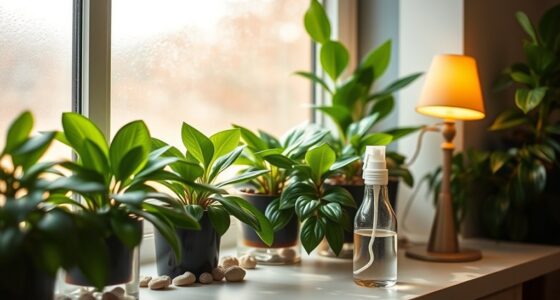To care for your Pilea Peperomioides, keep its soil consistently moist but not waterlogged by watering once a week during the growing season and less in cooler months, checking moisture levels regularly. Use well-draining soil enriched with organic matter, and place the plant in bright, indirect light. Maintain a temperature of 65–75°F and moderate humidity. Following these basics will help your pancake plant flourish—stay tuned for more tips to guarantee its health.
Key Takeaways
- Water once a week during the growing season, allowing the top inch of soil to dry out between waterings.
- Use well-draining soil with organic matter, ensuring proper aeration and slightly acidic to neutral pH.
- Provide bright, indirect light; avoid direct sunlight to prevent leaf scorch and legginess.
- Maintain temperatures between 65–75°F (18–24°C) and moderate humidity for optimal growth.
- Regularly check soil moisture to prevent overwatering and root rot, adjusting watering frequency seasonally.

If you want your Pilea Peperomioides to thrive, understanding its care needs is essential. One of the most important aspects is establishing a proper watering schedule and ensuring the soil requirements are met. This plant prefers its soil to be consistently moist but not waterlogged. Overwatering can lead to root rot, so it’s crucial to let the top inch of soil dry out between waterings. During the growing season, you might find yourself watering once a week, but in cooler months, reducing this to every two or three weeks is usually better. Always check the soil moisture first—stick your finger about an inch into the soil, and if it feels dry, it’s time to water. If it still feels moist, hold off a few more days. Consistency is key to preventing stress on the plant and encouraging healthy growth.
When it comes to soil requirements, your Pilea Peperomioides prefers a well-draining, aerated mix. A good choice is a standard houseplant mix combined with perlite or coarse sand to improve drainage. Avoid using heavy, clay-based soils that retain too much moisture, as they increase the risk of root rot. The soil should retain some moisture but quickly drain excess water to keep the roots healthy. The pH level should be slightly acidic to neutral, around 6.0 to 7.0. You can also add organic matter like compost to provide nutrients and improve soil structure. Proper soil conditions help the plant absorb nutrients efficiently and maintain a healthy root system, which directly affects its overall vigor.
Besides watering and soil, pay attention to the environment where you place your Pilea. It prefers bright, indirect light; direct sunlight can scorch its delicate leaves, while too little light can cause legginess and slow growth. Keep the plant away from drafts and temperature extremes, ideally between 65-75°F (18-24°C). Humidity isn’t as critical but maintaining moderate moisture levels in the air can help prevent leaf edges from browning.
Frequently Asked Questions
How Often Should I Fertilize My Pilea Peperomioides?
You should fertilize your Pilea Peperomioides about once a month during the growing season, typically spring and summer. Stick to a balanced, water-soluble fertilizer to meet its nutrient requirements, but avoid over-fertilizing, which can harm the plant. During fall and winter, cut back or skip fertilizing altogether, as its growth slows down. This fertilizer schedule keeps your pancake plant healthy and thriving year-round.
Can Pilea Peperomioides Thrive Outdoors Year-Round?
You can’t keep your pilea peperomioides outdoors year-round if you’re in a climate with cold winters or extreme weather. The outdoor climate must be warm and stable, ideally above 50°F, with indirect sunlight. During seasonal changes, you’ll need to bring it inside or provide protection. Adjust your care based on the season, ensuring it’s not exposed to frost, heavy rain, or direct harsh sunlight that could damage the plant.
What Are the Common Pests That Attack Pancake Plants?
You should watch out for common pests like mealybugs, which cause white, cottony infestations, and spider mites that create tiny webs and stippling on your plant’s leaves. To prevent spider mite infestations, increase humidity and regularly spray your pancake plant with water. If you notice signs of mealybugs or spider mites, act quickly with insecticidal soap or neem oil to protect your plant’s health.
How Do I Propagate Pilea Peperomioides From Cuttings?
A picture is worth a thousand words, so imagine a healthy, freshly cut stem. To propagate your Pilea peperomioides from cuttings, cut a stem just below a leaf node. Place the cutting in water and wait for roots to develop, which signals good root development. Once roots are a few inches long, transfer it to soil. Keep it moist and bright, and you’ll soon see your new plant thrive.
Is It Normal for My Plant’s Leaves to Turn Yellow?
It’s normal for your plant’s leaves to turn yellow occasionally, but it often signals an issue with plant health. Yellowing leaves can result from overwatering, underwatering, or too much direct sunlight. To keep your Pilea healthy, check your watering habits and make certain it’s getting bright, indirect light. If you notice persistent yellow leaves, adjust your care routine to promote overall plant health and prevent further issues.
Conclusion
Now that you know the basics of caring for your pancake plant, you’ll be able to keep it healthy and thriving. Remember to water it sparingly, give it bright, indirect light, and watch it grow into a beautiful, conversational piece. With a little attention and love, you’ll enjoy its unique charm for years to come. Isn’t it rewarding to see your plant flourish with just a little care? Happy gardening!








